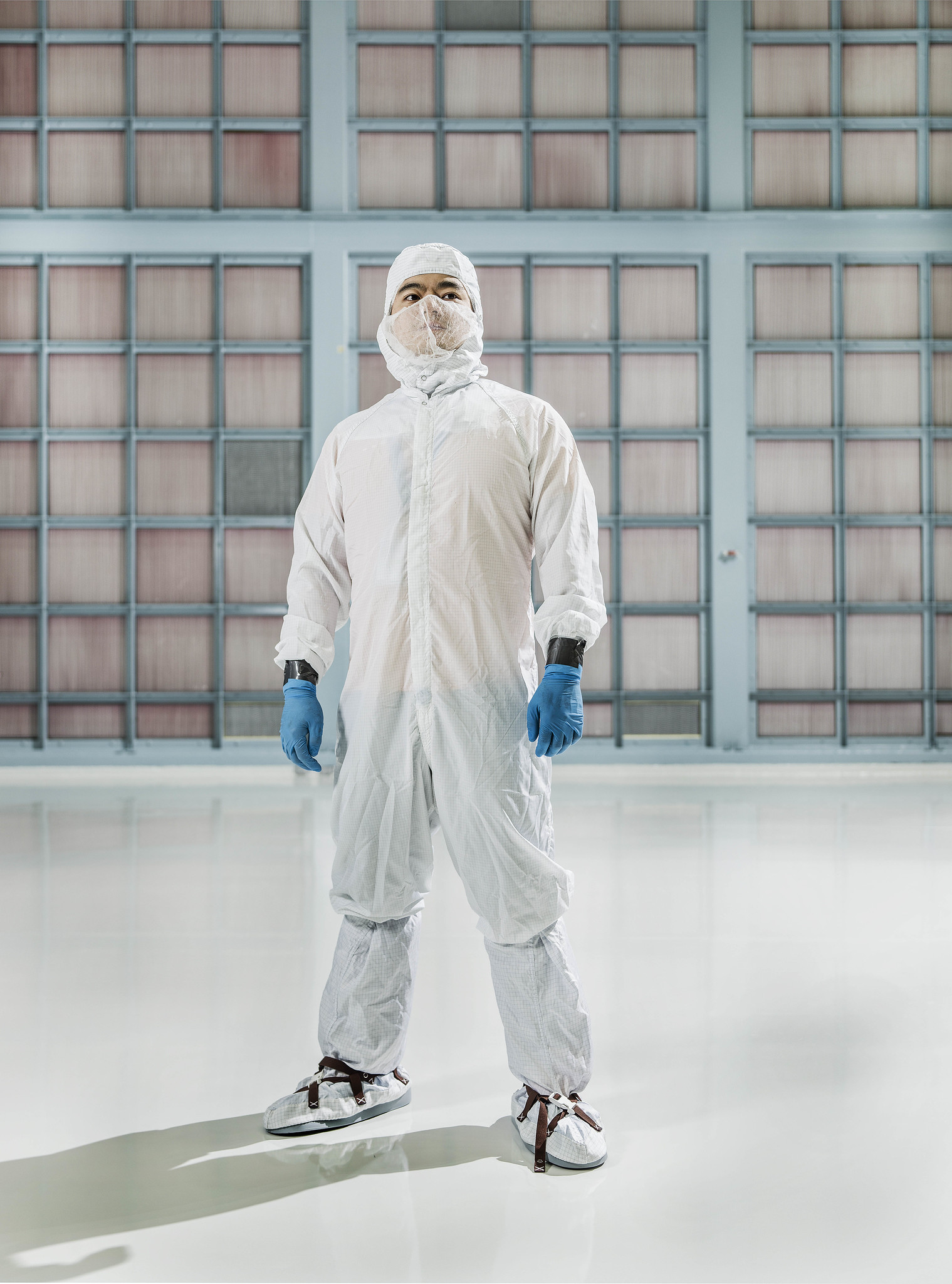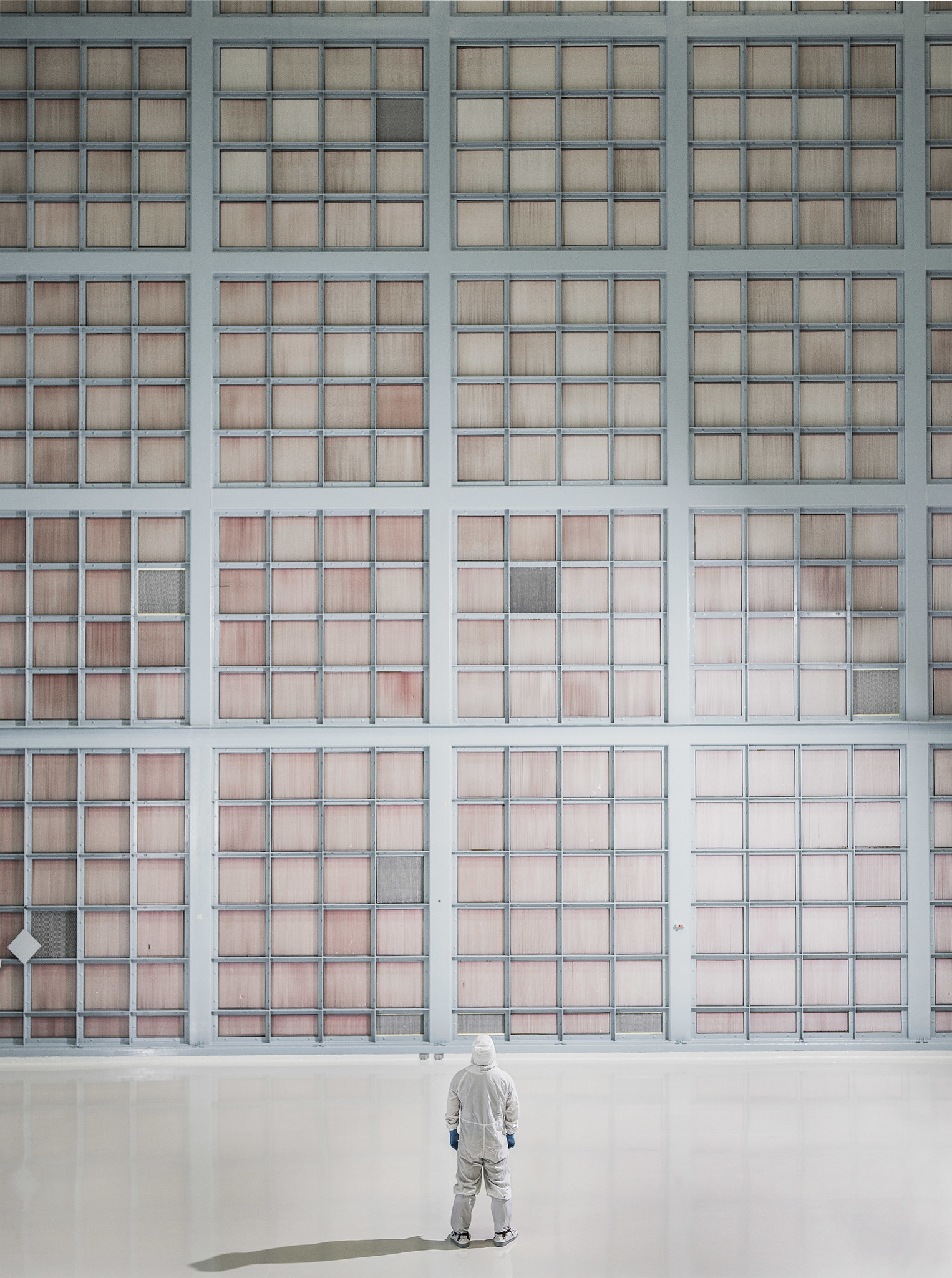Name: Yingrui Z. Huang
Title: Contamination control engineer
Organization: Code 549, Integration and Testing Division, Engineering Directorate
What do you do and what is most interesting about your role here at Goddard? How do you help support Goddard’s mission?
My job is to maintain one of the largest clean rooms in the world, the Spacecraft Systems Development and Integration Facility (SSDIF), in Building 29. Maintenance involves checking air quality, materials and monitoring personnel that go in and out.
The SSDIF is 1.3 million cubic feet, about eight stories high. It is 125 feet wide by 120 feet long, which means it is about as wide and as long as three basketball courts.
From November 2018 through April 2019, we underwent a series of tests and upgrades. We just upgraded our floor, which was almost 30 years old, and our lights to LEDs. We also tested our HEPA filter bank, which were fabricated in 1989 and made operational in 1992. The filters were designed for 50 years, but we want to verify the design and this is our first chance to test these filters to see how much longer they will last.
What made a biochemist become a contamination control engineer?
I have a B.S. in biochemistry from the University of Maryland and I am studying for an M.S. in systems engineering from Johns Hopkins. I was running a lab in the private sector that manufactured meningitis vaccines when I got a call from a temp agency asking if I was interested in a contamination control engineering position. Since both worlds exist in clean rooms with similar concerns, I jumped at the opportunity.
It was a once in a lifetime opportunity. As a kid, I loved the Smithsonian National Air and Space Museum and always wanted to be an astronaut. Working at NASA was my nerdy kid dream!
Where did you start at Goddard?
I came to Goddard in 2013 as a contamination control engineer on the James Webb Space Telescope. The science instruments of the Webb telescope and the optical telescope element were initially integrated in Goddard’s large clean room.
When the telescope and pathfinder was tested in Houston, I traveled with it and remained there for the four years of testing. After Houston, the Webb telescope was shipped to Los Angeles for integration onto the spacecraft and I returned to Goddard.
What is your current position at Goddard?
I am the SSDIF lab manager. Thankfully, my predecessor still mentors me.
How do you not obsess about contamination?
Well, the short answer is that we do. We test constantly.
We have live monitoring in the room for particles, temperature, relative humidity, corrosion and molecular contamination. We have interconnected sensors throughout the clean room which send results to our operation and engineering teams.
We have three stages of filtration for all of our air, as opposed to the typical one. Engineering control features allow us to basically control temperature and relative humidity to within one degree over eight stories. In a corporate office building, this range is usually around at least 10 degrees.
We are confident that the room is clean because of the original design goal was to preserve this room for as long as possible. Engineering features were built in that did the job three times as well as expected. A lot of the credit is due to the original designers of the room.
What made the James Webb Space Telescope challenging to have in the clean room?
When the Webb telescope was testing its optical functions, 1 degree of temperature change could make a huge difference. The same was true of humidity. Webb was also special because of the enormous size of the mirrors, all of which were exposed to the environment. Of course, we also had a very tight contamination amount of particles allowed.
What is your current focus?
After the upgrades, Restore-L, a servicing satellite, will come into the clean room for integration and testing. Restore-L will be a dramatic shift from Webb because its main function is robotics and remote sensing. These are all very finely-tuned instruments posing new anti-contamination challenges.
Are you responsible for Goddard’s other clean rooms?
Yes, I watch over Goddard’s nine other clean rooms within the Integration and Testing Complex. Other people are responsible for the smaller clean rooms around campus.
In addition to the constant contamination monitoring, how often is the SSDIF physically cleaned?
We clean the rooms and hardware during the day, every single day. Our team of 14 contamination control techs do everything from cleaning the room to cleaning all hardware that enters the room. Cleaning the clean room is like painting the Golden Gate Bridge, once the painters have finished they begin again. It never stops.
We use several chemical solvents. For special cases, we will bring in more exotic cleaning methods like CO2 (that is, carbon dioxide) snow cleaning. Basically, we freeze CO2 and then spray it on top of an optical surface, then the CO2 attaches to particles and everything sublimates off without leaving a trace. We call this snow cleaning because the CO2, which looks like thinly shaved dry ice, resembles snow when sprayed.
In a house, the HVAC filter is about one inch thick and changed every one to three months. We have three levels of filters, meaning that the air is filtered three separate times before returning to the room. Our HEPA filters are 12 inches thick and are two feet by two feet. They are made of a Teflon matrix and weigh about 45 pounds each. The SSDIF has 1,600 HEPA filters alone with around 900 other pre-filters. As I mentioned, we recently changed 20 of the 1600 HEPA filters and the other filters are changed annually on a rotating basis.
How are people decontaminated before entering the SSDIF?
It is a three-room process. You enter from the building into a changing room, put on a bunny suit and otherwise get ready, and then enter the clean room. Everyone wears a bunny suit and tucks their loose hair into the bunny suit. The bunny suits are our first and last line of defense against human contamination. They are made out of a unique polyester and carbon blend to eliminate electrostatic issues and are specially laundered and tested.
We do not allow perfumes, cologne, jewelry or watches. Jewelry creates friction on the skin which makes your skin shed regardless of humidity. We don’t want the skin contamination, which is really just dust.
What is the coolest thing you’ve ever done as part of your job at Goddard?
On the job, the coolest thing I’ve done was help clean the primary and secondary mirrors of the Webb telescope.
Off the job, the coolest thing I’ve done happened while I was in Houston with JWebb — I met my lovely fiancée. We recently got engaged while we were vacationing in Vancouver.
What makes Goddard a great place to work?
Goddard gives people the opportunity to try things. Goddard has faith in its people to be able to do great things. Goddard believes in its people.
I was a biochemist with no prior aerospace experience and Goddard was willing to take a chance on me. The team I worked with were patient and surrounded me with experts who mentored me.
Goddard surrounds smart people with smarter people.
Is your home immaculate?
Yes, I am a very clean person. I do all the cleaning, which my fiancée greatly appreciates.
Is there something surprising about you that people do not generally know?
I am a triathlete and have finished one Ironman, which has a 2.4 mile swim, 112 miles on a bike and a full 26.2 mile run.
Also, I was an amateur boxer but not anymore. It just doesn’t look right to show up at work with a black eye, plus it hurts more when you are over 30.
By Elizabeth M. Jarrell
NASA Goddard Space Flight Center
























